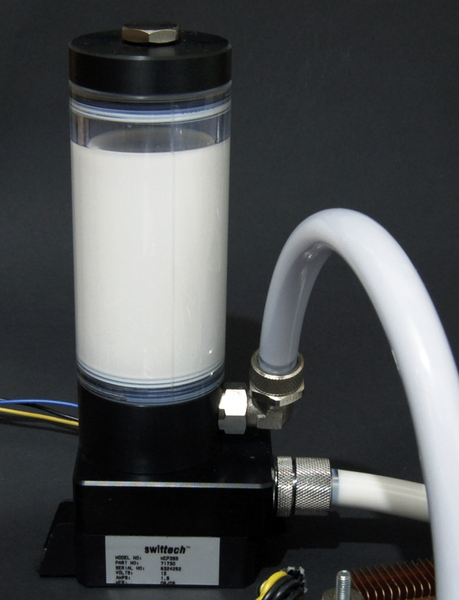Finally, I get to publish some more testing results here on XS. It's been a while since the "sandwich-thread" (still working on more testing for that) but today I can present you something... that you've already heard of dozens of times...
If you visit the forums regularly, I'm sure you have seen reference to and testing done with Nanofluid. I can present nothing groundbreakingly new here but IMO verification of testing that has already been done is just as important as the new and groundbreaking stuff.
Before I get into testing methods and resulst, I want to thank relttem for being so generous and shipping a bottle of Nanofluid half way around the world so I can play with it.
Nanofluid
Here's what the Nanofluid looks like:
Visually, it resembles milk very much. The viscosity of the fluid is more or less like that of water, i.e. it's very much just a liquid even though it looks like it might be denser than water.
This is an important factor since we're using the Nanofluid with components that were designed to be used with water. More on this later.
Testing method
I decided to test the fluid with three different radiator setups.
Some of you might remember that Skinnee used different flow-rates and got different results from those. Using the different radiator setups amounts to something similar: three different fluid temperatures.
Radiator-Setup 1:
The first setup simply consists of one Magicool Slim 120 radiator and a Nanoxia FX-1250 fan set to run at 1030 rpm. This is very little cooling and will provide high liquid temperatures.
Radiator-Setup 2:
For the second set of test-runs, I use the same radiator but add a second fan (also @ 1030 rpm) so that I get a two fan push-pull on the radiator. This lowers liquid temperatures.
Radiator-Setup 3:
Finally, I use an Aqua Computer airplex pro 240 radiator with two Nanoxia fans @ 1030rpm to achieve lower liquid temperatures again.
I run a loop with a Laing DDC, EK X-Res top, the radiator and an EK Supreme sitting on a Q6600 @ 1.5V VCore.
There are two thermal sensors in the fluid (after the radiator, before the waterblock) and several digital sensors measuring ambient temperatures. Each test-run consists of 45 minutes warmup followed by 20 minutes of temperature logging. The CPU is loaded using Prime95 during the entire test-run.
I gather all the data from all internal and external sensors in a log-file and average them out to get the results.
Results
First, let's look at the liquid temperature minus ambient temperature (scale is in Kelvin, one Kelvin being one degree Celsius of temperature difference):
As we can see from these results, the two setups with lower temperatures don't show a clear difference between straight distilled water and Nanofluid. Taking into account a margin of error due to imperfect measurement, the 0.4 and 0.1 K differences shown with the dual-fan setups could just as well be caused by chance.
However, in the setup with only one fan on a 120 radiator, we see a very distinct difference in performance between the two fluids.
If we look at the absolute temperatures of the different test runs, it seems that somewhere around 33 degrees Celsius, Nanofluid "overtakes" water as a coolant. I'm not sure whether it's the absolute or relative temperatures that matter though it's just clear that Nanofluid performs well in temperature ranges where water no longer performs well.
Let's have a look how the Nanofluid affects the CPU-Temperature:
Here, we see the same effect: At lower temperatures, the Nanofluid doesn't do any better than distilled water, but at higher temperatures, we see a clear advantage of the Nanofluid.
Further thoughts
Filling, bleeding draining and cleaning the loop when using Nanofluid is basically the same as when using water. I had a filter and the EK Supreme in the loop and found no signs of clogging, no residues and no coloration of the tubing caused by Nanofluid. The pump ran just like it does with water. In short: There seems to be absolutely no problem with using Nanofluid. I didn't do any long-term testing yet (since it's not that long since I got the fluid), but from what I've done with it I can say that it's easy to work with.
Conclusion
I usually do all my testing as described above: Open test-rig, only one heating component in the loop, etc. This is to make sure that error margins remain as small as possible.
Reading these test-results, you might be thinking: "What the hell should I do with a coolant that only has an advantage over water when I use tiny radiators? I like BIG radiators!"
To this, I reply: "Yes, so do I. But you might also like multiple GPUs, overclocking and cramming all you hardware and cooling inside a case."
What I'm trying to say with this is that I can imagine the Nanofluid showing significant benefit in systems with high heat-loads. In a multi-GPU-setup, fluid-temperatures can reach the kind of hights that Nanofluid benefits from in no time. I'd be very interested in seeing the Nanofluid's performance in a real life system with very high heatload as opposed to a test-rig. Unfortunately, I don't have such a system (sponsor me!).
Apart from the temperatures, there's one more thing to consider with Nanofluid: It allows you to fill your loop with a completely white, opaque liquid. It looks very nice and certainly doesn't have a negative impact on the temperatures. As much can't be said of many flashy UV- color-additives.
I leave you with some pics showing the loops filled with Nanofluid.
Hope you enjoyed reading. Cheers,
Shane
P.S.: Here's the link to the original, German article on DeXgo.
UPDATE: New results from a mini-test here.














 Reply With Quote
Reply With Quote
 .
. .
.












Bookmarks